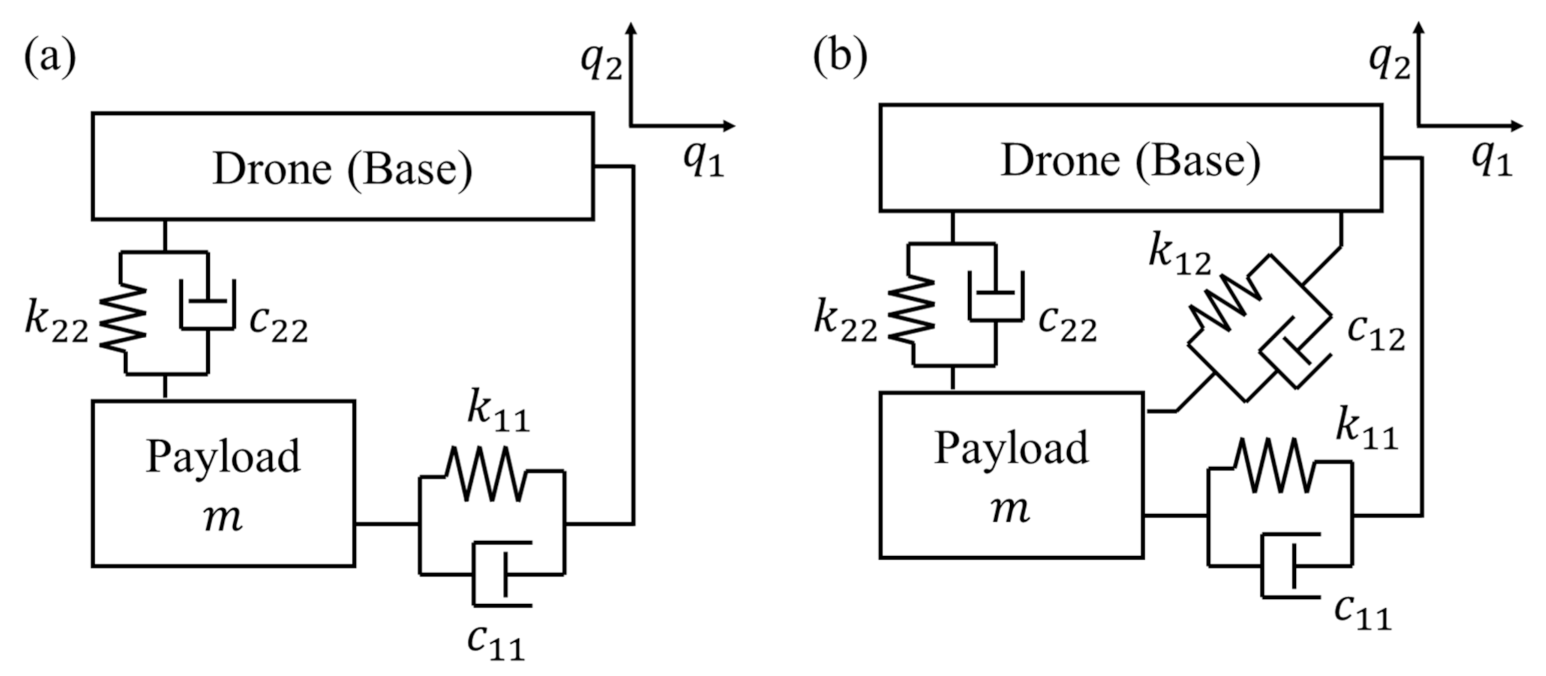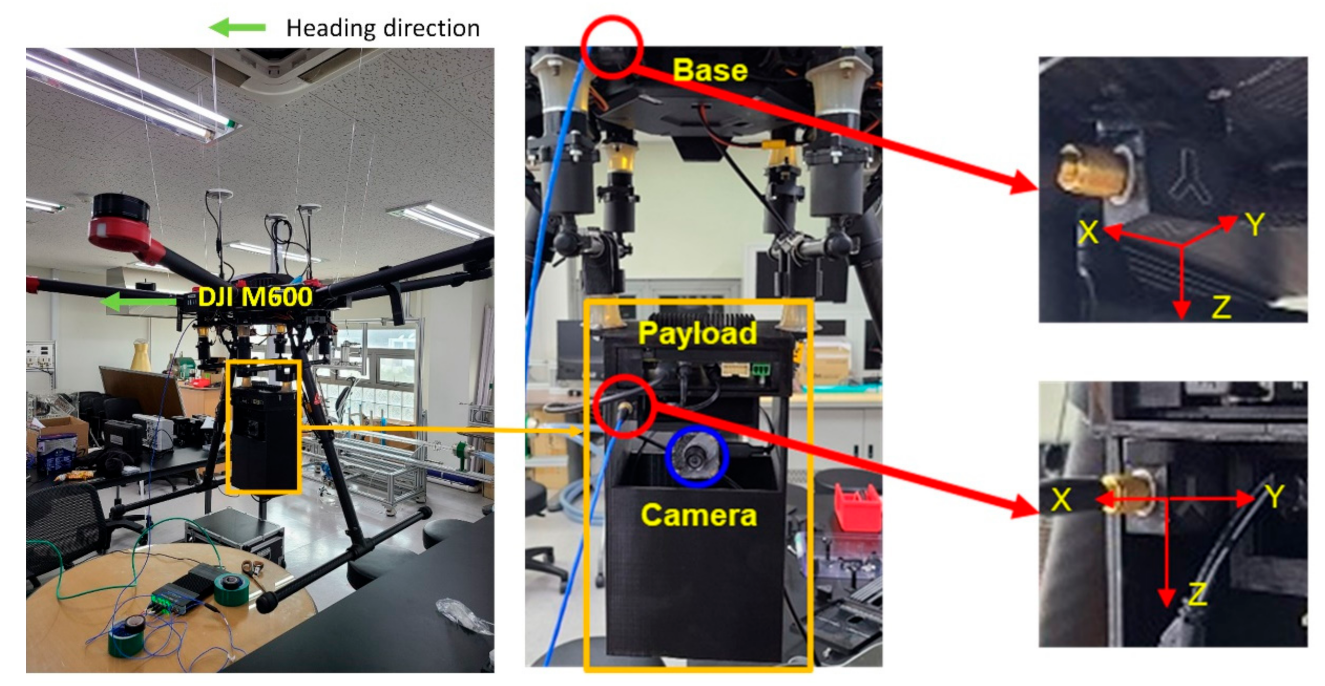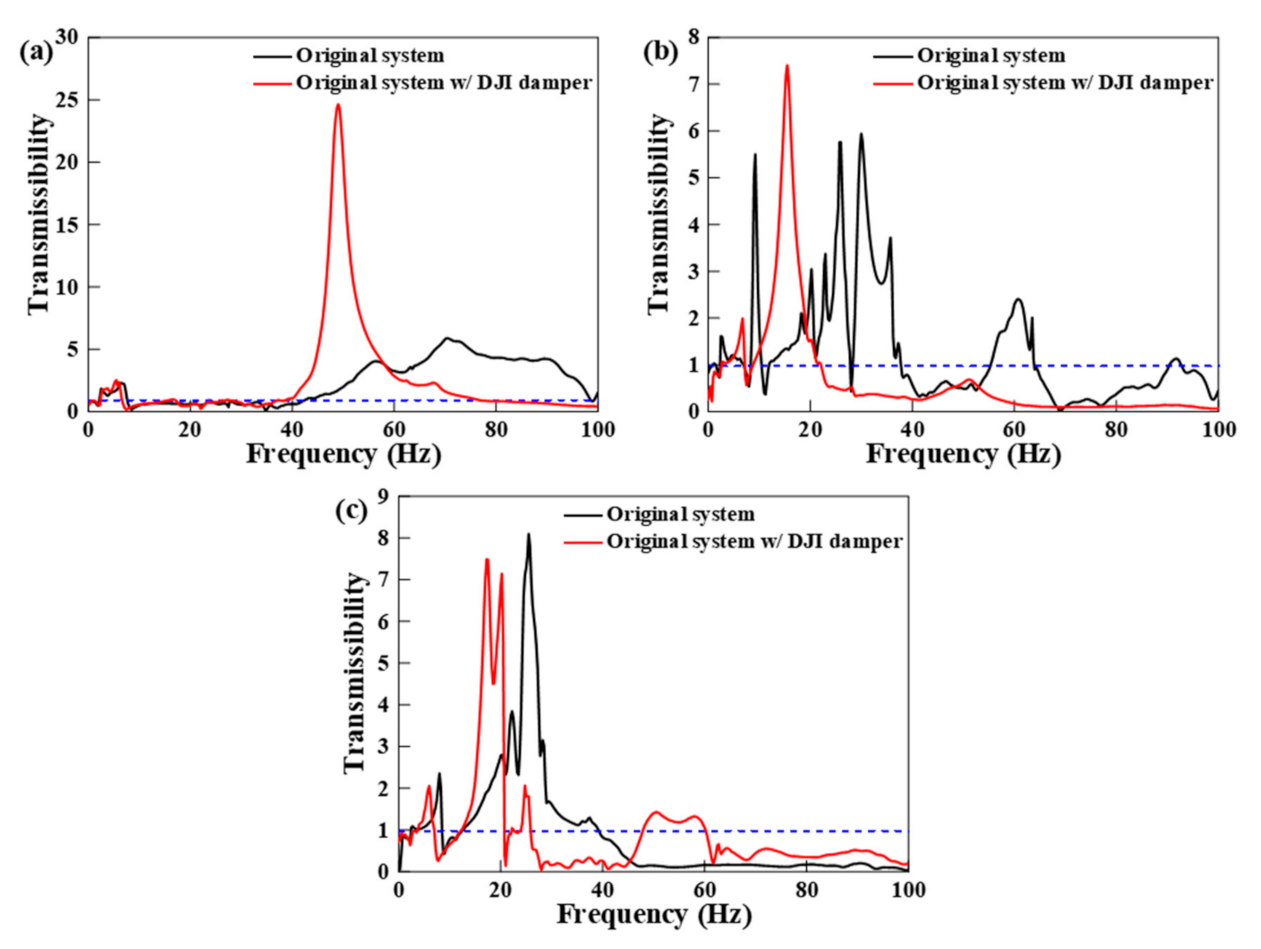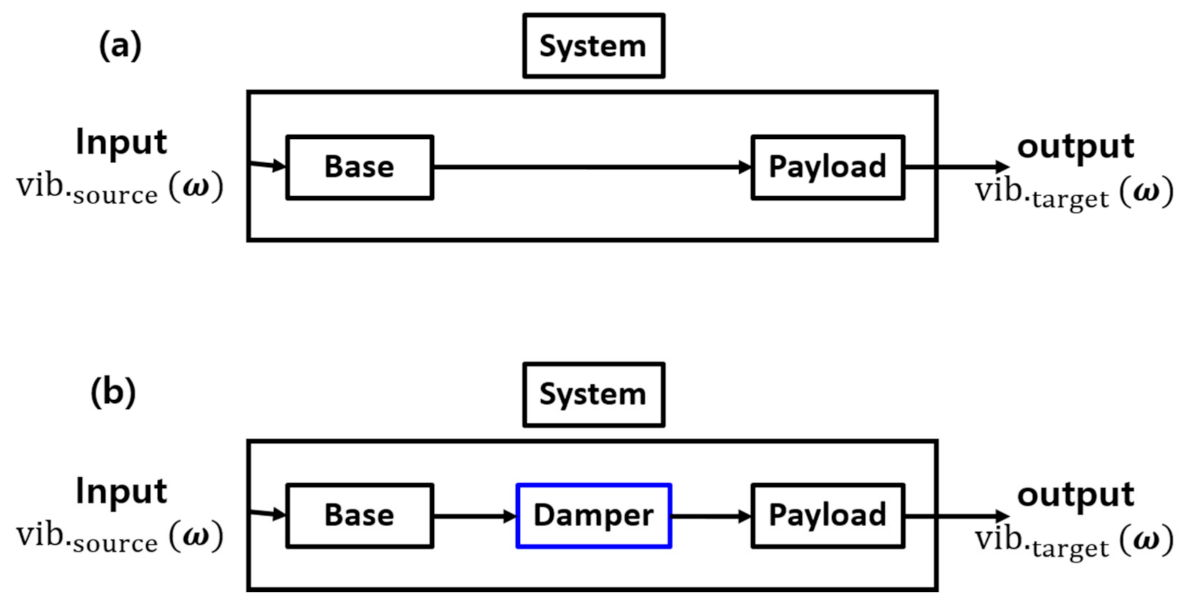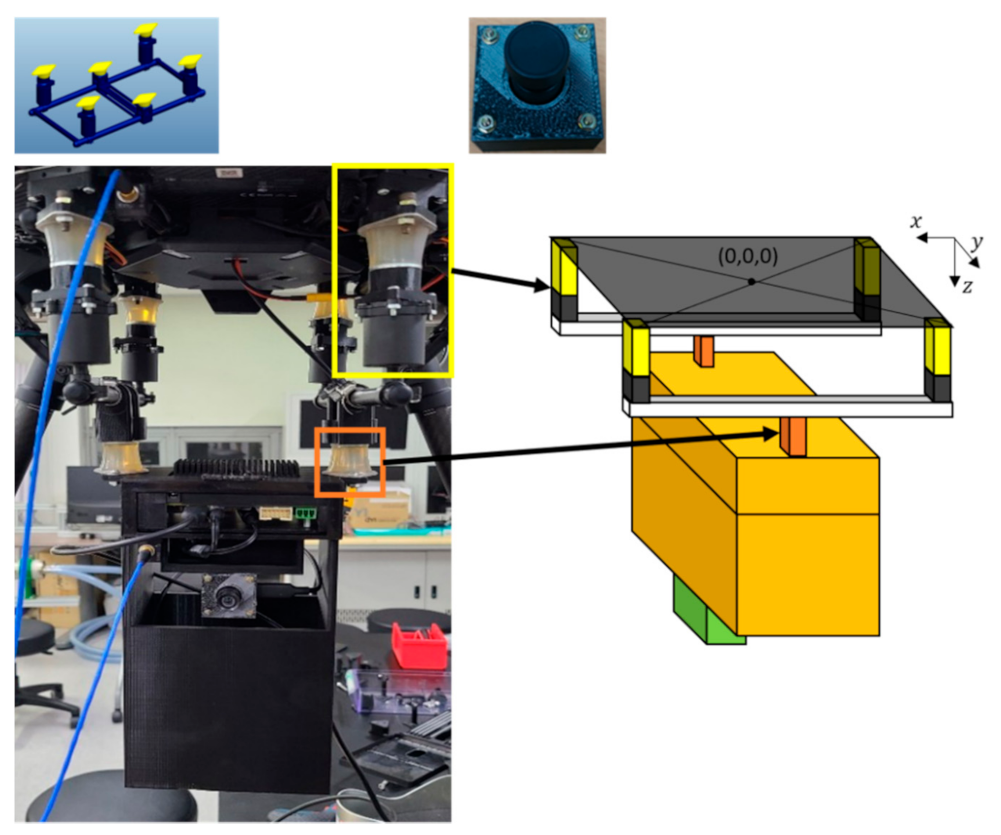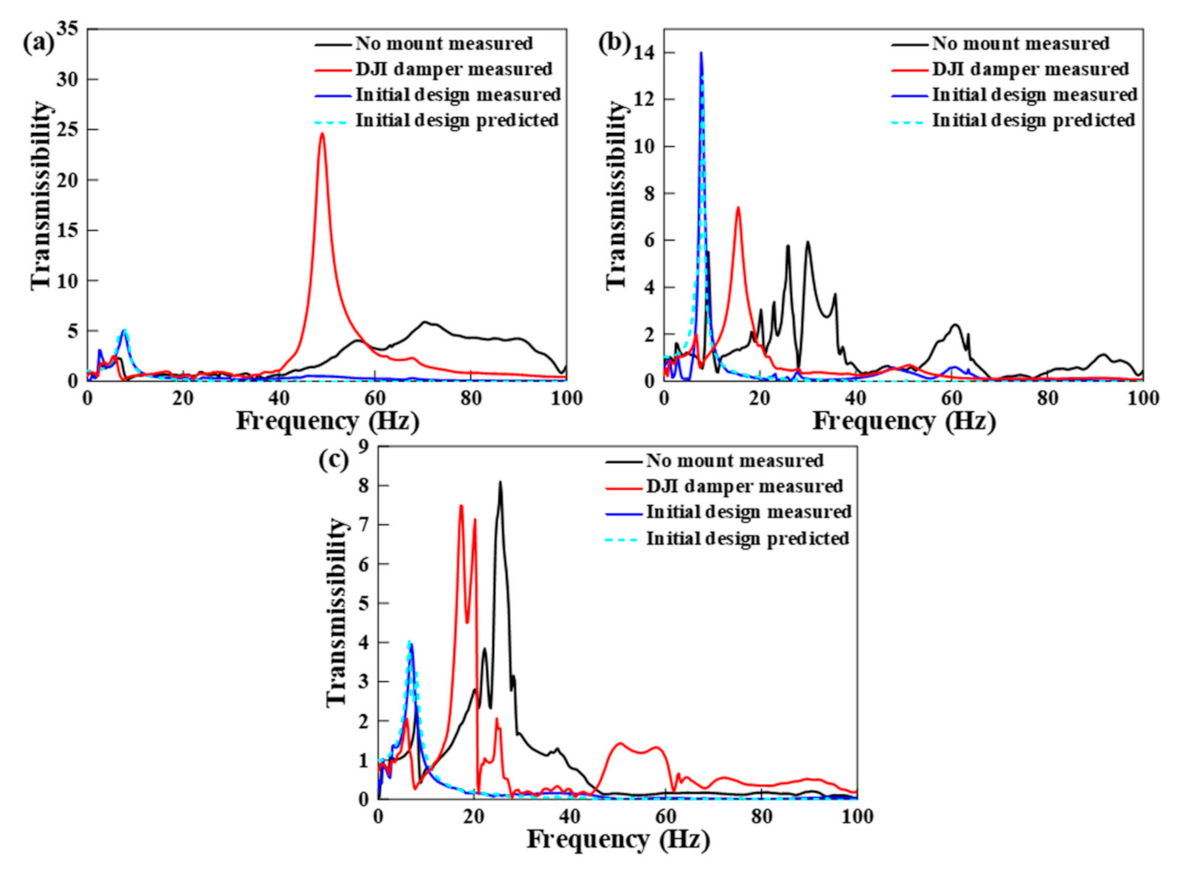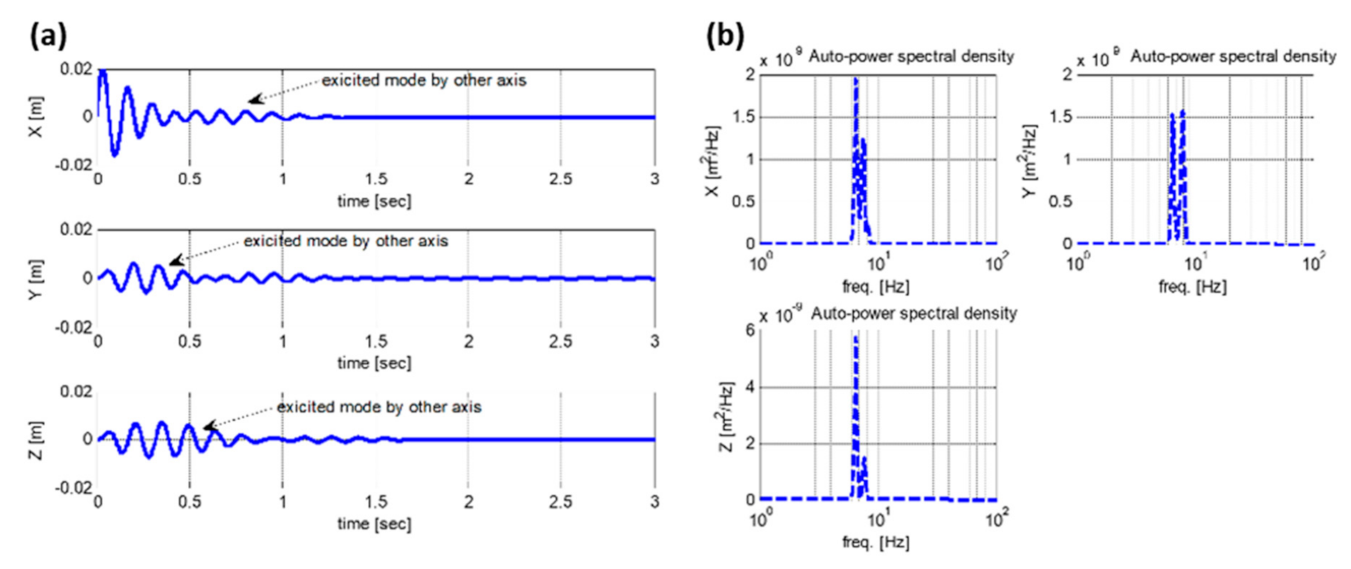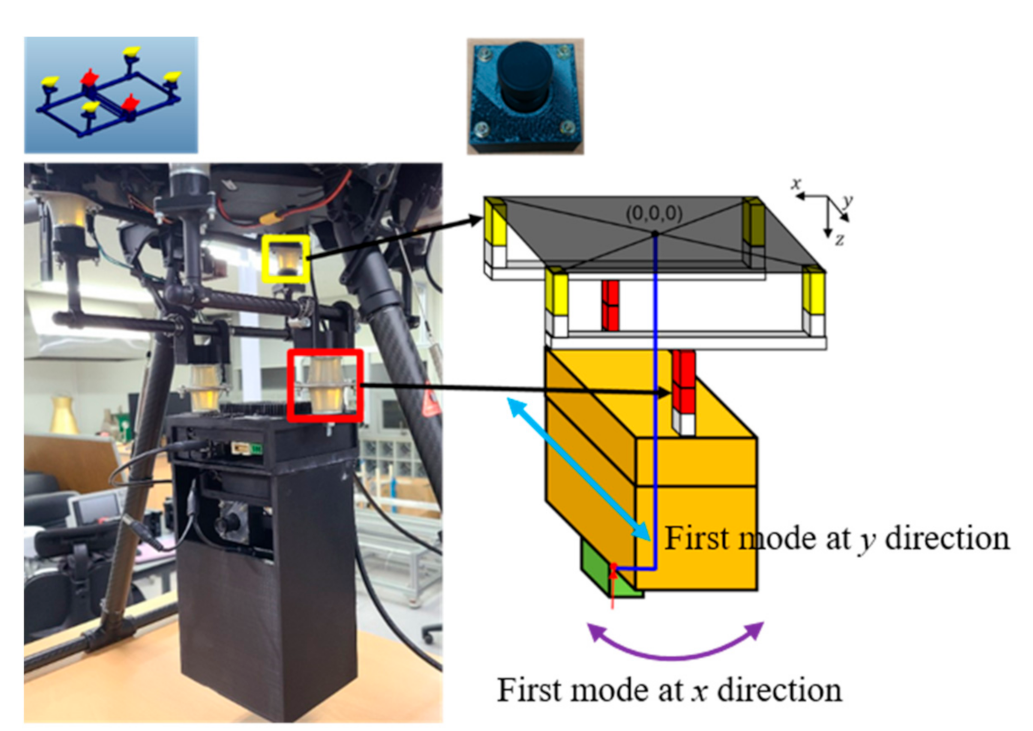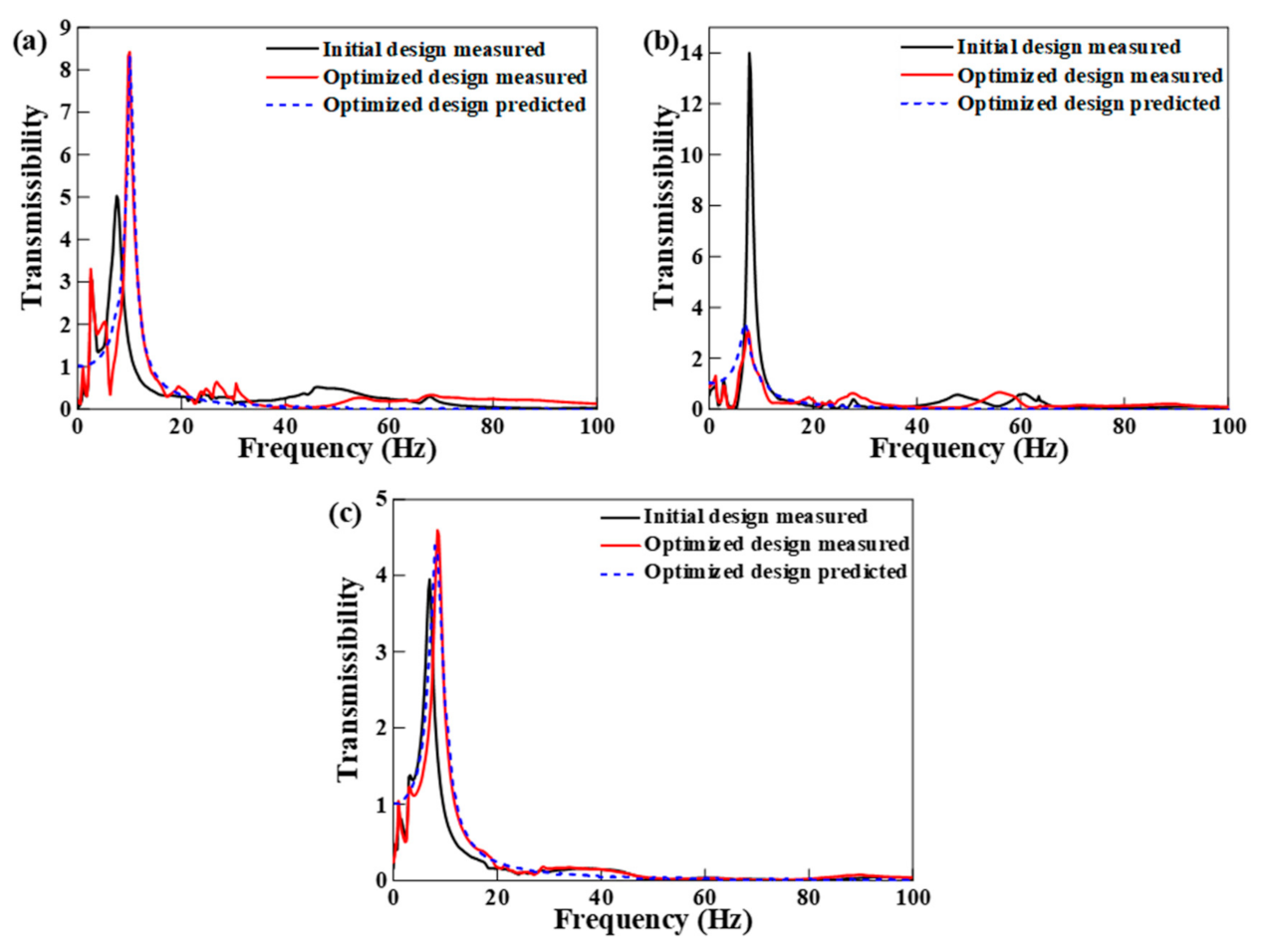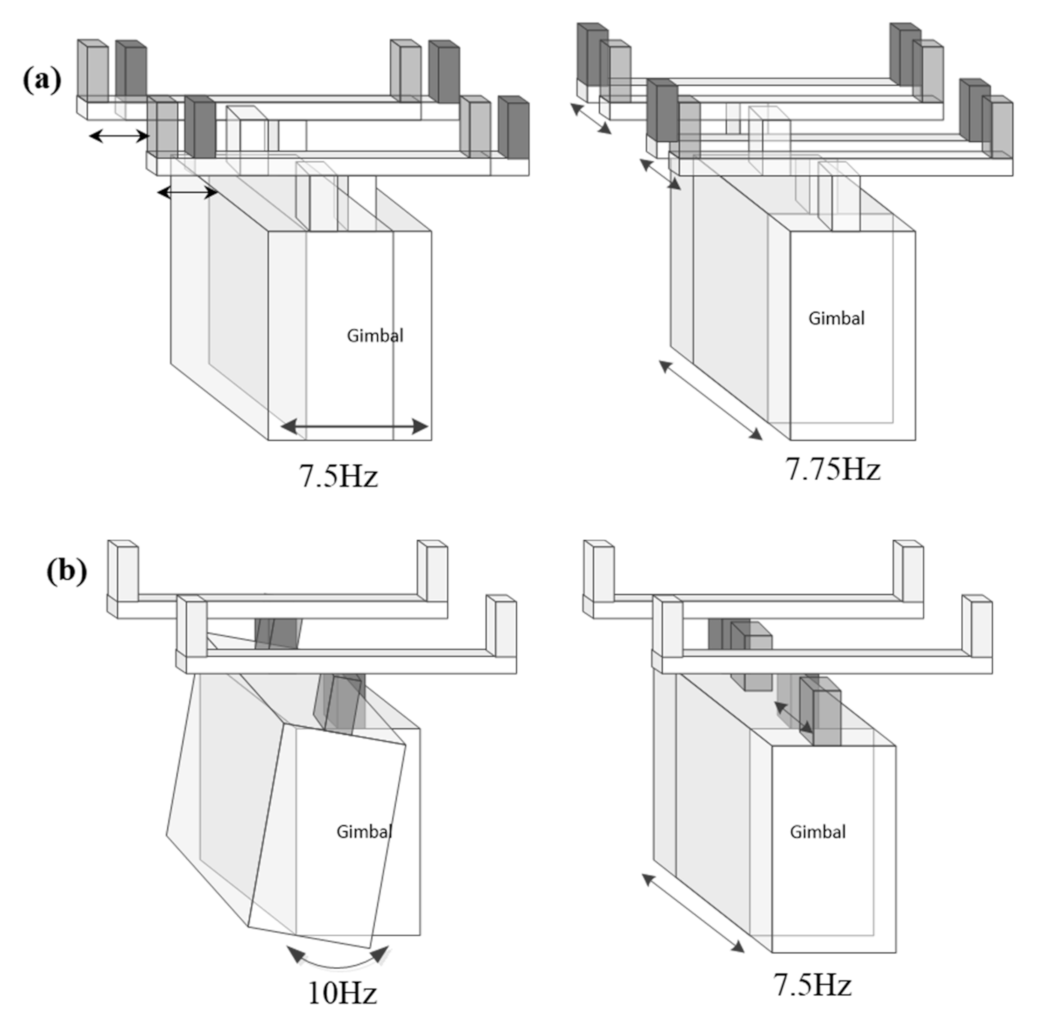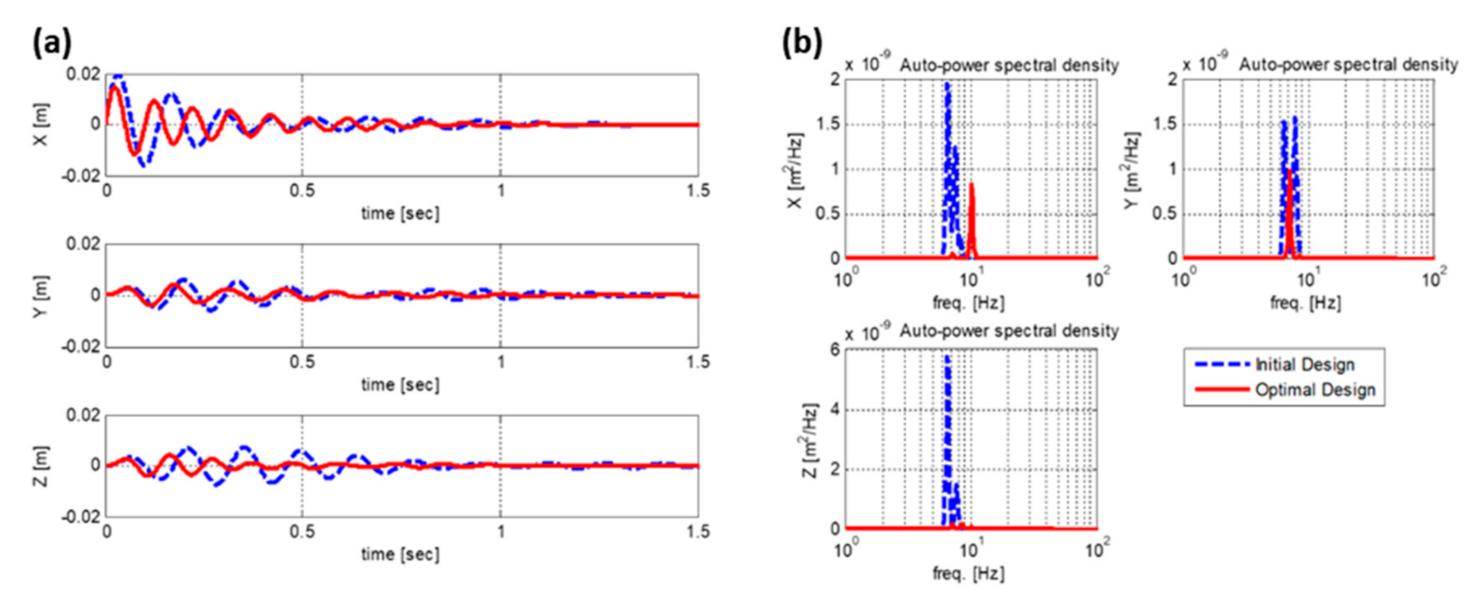This section presents the effectiveness of the proposed method through experimental and simulation approaches. First, vibration characteristics of the original system were analyzed with experimental results. Then, a design procedure of a vibration isolator is presented with system identification. Finally, performance enhancement of a vibration isolator for the proposed configuration is presented with a quantitative analysis on experiments, which compares the VIP of the original system.
4.1. Vibration Characteristics of the Original System
Frequency response functions were calculated using measured accelerations from modal testing for elucidating the vibration transmissibility between a source and a receiver for the original mobile surveillance system. Vibrations from the drone and surveillance system were measured by exciting the drone using an impact hammer. Note that an impact force was applied to the drone at an oblique direction to excite the mobile surveillance system in all directions. The transmissibility was calculated using Equation (19) (
Figure 3).
The operating frequency of the drone ranged from 30 to 85 Hz duringflight; therefore, this study aims to isolate the vibration in this range to minimize the transmission of vibrations to the camera in the corresponding frequency range. The black lines in
Figure 3 denote the transmissibility for the original system; it shows that transmissibility in various operational frequencies exceeds unity in all directions. It means that vibrations originating from rotors were first amplified and then transmitted to the camera in the surveillance system. Specifically, a frequency range of 43–85 Hz was amplified in the fore-after direction, that of 10–38 Hz and 55–64 Hz was amplified in the side-by-side direction, and that of 10–40 Hz was amplified in the vertical direction. It implies that vibration in all operating frequencies was magnified, and the tremble of vibration was being measured.
More information on the location and amplitude of natural frequencies in each direction is described in
Table 1. Interestingly, several natural frequencies of each direction overlapped. The frequency range of approximately 60 Hz of the fore-after and side-by-side directions overlapped; the third natural frequency of the fore-after direction was close to the fifth natural frequency of the side-by-side direction. The natural frequency close to 36 Hz of the side-by-side and vertical directions overlapped; the fourth and fifth natural frequencies of the side-by-side and vertical directions were close to each other, suggesting that vibrations of these directions were coupled to each other. It can be inferred from this observation that a coupled model should be used for system identification to ensure the accurate prediction of vibration responses. Moreover, side-by-side and vertical directions more significantly affect the blurriness of an image.
The most straightforward approach to isolate transmissibility for different operational frequencies is to install commercial vibration isolators in the gimbal (
Figure 4). Vibrations from rotors (
in
Figure 4) excite all components in a drone. The vibration is transmitted to the surveillance system through a gimbal that connects it to the drone causing vibration in the surveillance camera (
in
Figure 4), which suggests that a gimbal plays a critical role in transmitting vibration from the drone body to the surveillance system. However, vibration from rotors is transmitted to the surveillance system in an original configuration (
Figure 4a) owing to the lack of a vibration isolation system in a gimbal. Therefore, this vibration influences images recorded by a surveillance camera and deteriorates monitoring performance. Hence, a vibration isolation system is necessary for the better performance of a surveillance camera.
Four vibration isolators of DJI (a black isolator in a yellow box in
Figure 5) were installed where the gimbal and drone body connect, and then transmissibility was measured. The red lines in
Figure 3 demonstrate that this simple approach enhances the vibration isolation performance at different operational frequencies, especially in the side-by-side and vertical directions. However, significant amplification occurred at approximately 50 Hz in the fore-after direction. This resonance deteriorated the vibration isolation performance of the side-by-side and vertical directions. However, the coupling effect in the vertical direction could not be neglected because magnification was larger than one, and a broad range of operational frequencies, i.e., 50 to 60 Hz, were incorporated. This analysis suggests that the tested commercial vibration isolator is not suitable for the customized surveillance system used in this study. In conclusion, the vibration characteristics of the original system and that with the tested commercial vibration isolators suggest that the mobile surveillance system also needs a customized vibration isolation system that maximizes the performance of the surveillance system.
4.2. Design of a Vibration Isolation System Based on System Identification
The frequency response function for the original system and the tested commercial vibration isolators (
Figure 3) shows that the proposed gimbal significantly amplifies the vibration from the rotors in operational frequencies. This vibration causes deterioration of the images taken by the surveillance system, meaning that a vibration isolation system attached to the gimbal should be properly designed and implemented. The method to reduce vibration transmitted to a camera included two approaches: increasing the mass of the camera and decreasing the stiffness of the isolation element. The payload is limited in drones; therefore, the weight must be as light as possible. Hence, this study proposes a design methodology that lowers stiffness.
Commercial mounts having viscoelastic material with the lowest stiffness were used to lower the stiffness and locate the natural frequency below operational frequencies (
Figure 5). Specifically, eight dampers were installed between the drone body and the gimbal (a yellow box in
Figure 5), and two dampers were installed between the gimbal and the surveillance system (an orange box in
Figure 5). The equivalent stiffness of these white jelly dampers was
N/m, and that of black DJI dampers in
Figure 6 was unavailable. Hereafter, this configuration is defined as an initial design of a vibration isolator. Note that two dampers in a series decrease the equivalent stiffness of a vibration isolator. Hence, this simple design configuration is effective in isolating vibration from the rotors.
The frequency response functions for the actual drone system were measured in all directions to verify the vibration isolation performance of the proposed design (
Figure 6). The same procedure described in
Section 4.1 was performed in this analysis. The natural frequency in the vertical direction was 7 Hz (
Figure 6c). Moreover, the overall vibration in the vertical direction was reduced from 1.5899
RMS (for a gimbal without vibration isolators) and 1.5082
RMS (for a gimbal with DJI vibration isolators) to 0.6080
RMS in the 0–100 Hz frequency range, where RMS means the root-mean-square. The vibration was decreased by 61.76% (=1 − 0.6080
RMS/1.5899
RMS) and 59.69% (1 − 0.6080
RMS/1.5082
RMS) compared to the vibration of a gimbal without vibration isolators and that with DJI vibration isolators owing to the initial design suggestion. The effectiveness of a vibration isolation system in the operating frequencies was verified by comparing the original system with DJI vibration isolators. However, the natural frequency in the three translational directions was observed at similar locations in this configuration. Specifically, the natural frequencies were adjacent to each other at 7.5 Hz, 7.75 Hz, and 7.0 Hz in the fore-after, side-by-side, and vertical directions, respectively. Therefore, the natural frequencies could affect each other. In other words, the natural frequencies of each direction may be mutually amplified in this configuration because the excitation direction of the internally generated force occurs in the vertical direction and in an undefined random direction. These results also suggest that simply adding vibration isolators cannot be an optimal design. Therefore, it is necessary to simultaneously consider horizontal modes and a vertical mode while designing the vibration isolation system.
The response characteristics of the three-DOF system with adjacent natural frequencies for three translational directions were predicted with a coupled multi-DOF model to confirm this hypothesis. Therefore, a mathematical model of a three-DOF system accounting for coupled stiffness and damping can be derived as
where subscripts
and
denote payload, i.e., the surveillance system, and the base, i.e., the drone body. In Equation (25),
,
, and
denote the mass of the surveillance system, the equivalent damping coefficients of the vibration isolation system in the * direction, and the equivalent stiffness of the vibration isolation system in the * direction between the drone body and the surveillance system. This equation modified the coupled EOM in general coordinates (Equation (14)) by assuming that a drone body is a base excitation to design a customized vibration isolator. Note that the mass of the vibration isolation system was negligible in this configuration because it was much smaller than that of the surveillance system.
System identification was conducted using the Levenberg-Marquardt algorithm described in
Section 2.2 based on this coupled three-DOF model (Equation (25)). The measured frequency response functions were used for system identification. The initial values to be applied in the Levenberg-Marquardt algorithm were determined using reference values from the brochure or measurements. The stiffness information for the commercial mount was approximately 6.6 × 10
3 N/m, as mentioned in the specification sheet. The initial damping value was assumed to be 0.1, which is the general known damping ratio of a rubber [
23], and the mass was measured using a precision balance. The frequency range below 100 Hz was used. Therefore, we filtered the frequency range that lies above the target range using the ideal low pass filter in the frequency domain when applying the least squares cost function. The results (blue dotted lines in
Figure 6) show that estimated parameters correspond well to the experimental results because the correlation coefficients (
R) for the fore-after, side-by-side, and vertical directions were 0.91, 0.91, and 0.95, respectively. Parameters estimated from measurement results are described in
Table 2. The stiffness elements used for the coupled effects in each direction were assumed to be bounded between 1% and 25% of the stiffness in the main direction. This can be explained by the fact that the coupled-stiffness term observed from the experiment of the rotating machine was 1% to 25% [
24,
25,
26].
The response characteristics in the time (
Figure 7a) and frequency domains (
Figure 7b) with the initial velocity,
, of
in the fore-after direction was predicted based on the proposed model with the identified parameters. The transient response of the excitation direction first decreased; however, it increased again during the first second rather than attenuating continuously (
Figure 7a). This happened because of the coupling effect from the adjacent natural-frequency excitation in each direction, which caused the vibration-isolation performance to deteriorate. It can be better explained in the frequency domain (
Figure 7b). There were two peaks in each coordinate, resulting from the coupled effects in each coordinate. The DJI damper has the lowest stiffness as per the composition of the actual isolation elements, as shown in
Figure 6; it is the main factor in determining the natural frequency. Moreover, the symmetrical arrangement and the cylindrical shape of this damper results in the same horizontal stiffness. Therefore, it can be inferred that a similar natural frequency was observed at the fore-after and side-by-side directions, resulting in coupling effects. In other words, the geometric configuration of the initial design creates a situation in which natural frequencies in mutual directions are coupled and adversely affect the performance. Hence, the optimization process should be further improved based on model-based system identification.
4.3. Design Enhancement of Vibration Isolator for a Camera System Deployed in a Drone
The direction of the design optimization can be considered to change the location of the vibration isolators or replace the vibration isolator with various stiffnesses. This study attempts to replace vibration isolators to minimize design change and improve isolation performances. The vibration mode of each direction should be different from decoupling the first natural frequencies in the horizontal directions. However, both modes were translational in the initial design owing to the symmetric configuration of vibration isolators and the lowest stiffness of the DJI damper. Moreover, the stiffness of the vibration isolators on the gimbal side (a red box in
Figure 8) should be lower than that of the drone side (a yellow box in
Figure 8) to solve this problem. Therefore, the black DJI vibration isolator was removed from the drone body, and two jelly dampers were connected in a series for the surveillance system (yellow and red boxes in
Figure 8). This configuration had the main stiffness element on the surveillance side, owing to the softest equivalent stiffness of two jelly dampers in a serial connection. Moreover, a mode of the first natural frequency of the fore-after direction was changed from a translational to a rotational (a purple arrow in
Figure 8) because the surveillance system was hung at one point in this direction based on the proposed configuration. On the contrary, a vibration mode of the side-by-side direction was still translational (an azure arrow in
Figure 8) because the surveillance system was hung at two points in this direction, implying that a different mode of each direction results in different natural frequencies of each direction. Furthermore, removing the black DJI vibration isolator increased the equivalent stiffness in the vertical direction, resulting in an increase in the natural frequency in the respective direction. In summary, the natural frequency in the side-by-side direction changed minimally owing to the same mode shape compared to an initial design. On the contrary, the first natural frequencies of the fore-after direction significantly changed because the first mode changed from a translation to a rotational mode. The first natural frequency in the vertical direction may also shift to a higher frequency than the initial design owing to an increase in the equivalent stiffness. This configuration aims to maintain constant stiffness in the side-by-side direction. However, stiffness of the fore-after and vertical directions increases, which decouples the natural frequency of all directions.
The transmissibility was measured to validate the proposed suggestion (
Figure 9). The position of natural frequency (
) was derived from the suggested design and not from the initial design (
Table 3). The natural frequencies of the optimal design were 10, 7.5, and 8.5 Hz for each direction; this means that it was separated by more than 1 Hz for each direction and, therefore, coupling effects were reduced compared to the initial design.
System parameters were identified using the coupled three-DOF model shown in Equation (25) to verify whether this configuration could separate the first natural frequency in each direction while taking the natural frequency position as low as possible. The predicted transmissibility in each direction is shown as blue-dotted lines in
Figure 9; this corresponds well with the measurements. From the measurement and prediction, the rigid body mode shape could be estimated as shown in
Figure 10. The mode shape caused by the double mount on the side close to the drone body in the initial design was modified toward to the double mount on the side close to the gimbal, and the position of the coupled modes in the horizontal directions was separated, as shown in
Figure 9. In addition, in moving the mounts toward the camera gimbal as much as possible, the unwanted vibration amplification of more than 10Hz observed in the isolation frequency range of
Figure 3 and
Figure 6 was significantly reduced. Specifically, the R of the fore-after, side-by-side, and vertical directions were 0.95, 0.82, 0.97, respectively. Therefore, this model was used to predict responses with the initial velocity,
, of
in the fore-after direction. All assumptions excluding the stiffness change in the natural frequency location redesign were the same; the results are shown in
Figure 11. Following the design optimization purpose, the first natural frequency of the side-by-side direction was approximately the same, but it had only one peak (
Figure 11). Moreover, the first natural frequency of the fore-after and vertical directions shifted to higher frequency regions compared to the side-by-side direction, suggesting that the natural frequency of each direction was decoupled. This is also shown in the responses in the time domain (
Figure 11a). The responses attenuated continuously over a period in all directions, and no coupling effect was seen. It was again proven from the prediction results with the coupled model that the peak value in the time domain decreased. Moreover, the settling time also decreased in all directions for the same condition. Additionally, it can be seen that even in the frequency domain, vibration levels in the range with the highest peak or two simultaneously observed peaks decreased via mode separation.
Finally, the transmissibility of the drone was measured under the operating condition of the take-off motor without the blades. It was compared with the RMS and ratio between a payload and base in the operational frequencies in the range of 30–85 Hz (
Table 4). This comparison was aimed to quantitatively examine the level of vibration reduction with the proposed design suggestion. The comparison exemplified two factors. First, introducing the vibration isolator decreased the transmissibility in all directions. Specifically, the surveillance system showed a significant amplification in the fore-after and side-by-side directions when the vibration isolator was not installed in the drone. Second, introducing a jelly damper with the proposed configuration decreased transmissibility in all directions. However, the same stiffness in all directions and symmetric configuration at the initial design resulted in coupling effects, which caused the isolation performance to deteriorate. On the contrary, the suggested design reduced coupling effects of the natural frequency for each coordinate and enhanced the vibration isolation performance. It implied that design optimization with the model-based system identification plays a crucial role in ensuring the performance of the surveillance system. This effect is clearly seen in the vibration ratio between a payload and base. The last row in
Table 4 shows that VIP was 98.3%, 94.0%, and 94.6% in the operational range of frequency, i.e., 30–85 Hz, with the presented vibration isolator. However, VIP was 97.4%, 94.1%, and 86% for initial design suggestions in the fore-after, side-by-side, and vertical directions. Note that VIP is defined as a one-ratio of initial or suggested design over that of the original system. This implies that the present design of a vibration isolator shows better VIP than the initial design, suggesting that the proposed method is effective in isolating vibration from rotors.
